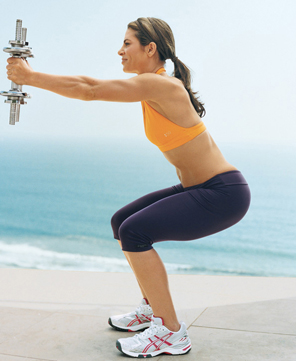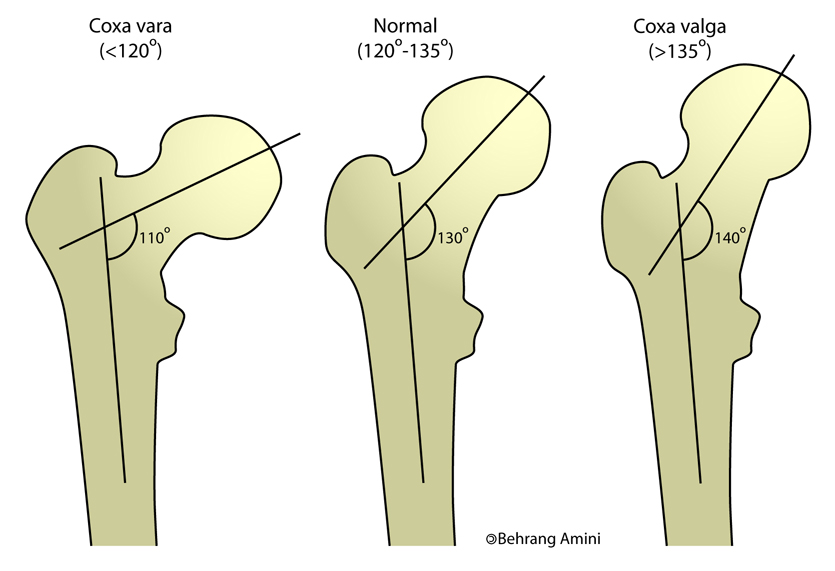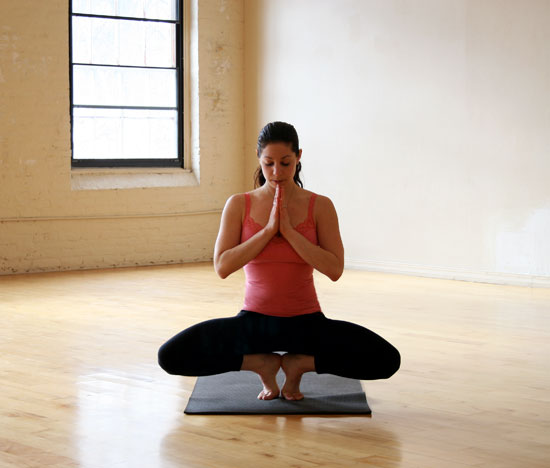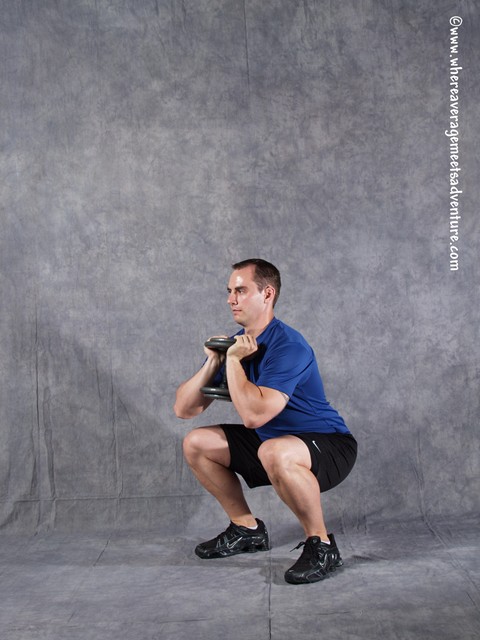Squats and Your Sex Life
Many of you are probably thinking, “Uh oh, I don’t think I should read this one. What’s Dean gonna tell me? He’s so weird, yet so amazingly smart and good-looking and good at checkers.” Well thank you, and I’m about to rock your WORLD with this post. You’ll giggle a little every time you see someone performing a squat.
Now before we get into the nitty-gritty here, I just want to take a second to let you know I’m not going to get into what positions you like, or whether you’re into S&M or how to pull crazy game at the bar this coming weekend or anything like that. This post isn’t about how to become the mackadocious marvel of the masses who holds their pimp cup high. What we’re going to discuss is what the squat mechanics you possess means to your ability to engage certain muscles, have certain flexibility, and what makes you want to enjoy naked time with others more or less based on how you squat. Crazy?? Maybe. Informative? Possibly. Fun to talk about? DAMN RIGHT!!!!
Them Bones
There’s pretty much no one optimal squat for everyone, primarily because there’s a lot of variation in what the person’s hips look like. The femoral neck has three common variations, high medium and low.
Combining these three different femoral angles with the three common hip angles, it gives 27 different hip complexes. On top of that, the femoral position in the acetabulum can either be in antetorsion (forward in the capsule) or in retrotorsion (back in the capsule) or in neutral which will alter squat mechanics even further.This means some people will never be able to do the splits no matter how hard they try because their joints aren’t built for it. Those who can however, will forever be viewed with reckless abandon by those who admire them for it, and thought of as whoreish bitches by those who can’t do it and hate them for it.
The natural ability of the hip to dip it low is going to be somewhat limited in a certain percentage of the population that has a less than favorable hip complex formation. This would make performing the squat a less-than-optimal movement for the individual, meaning they get less than optimal benefits, both in and out of the gym.
Foot Position
To start with, let’s take a look at what your squat stance is telling us. There’s essentially three different squat widths, we’ll call them narrow (feet within the width of your shoulders), neutral (feet at the width of your shoulders) and wide (feet wider than your shoulders). Most people with limited hip flexibility can’t squat with a wide stance without having their knees cave into valgus (knock-kneed) or having their ankles roll into inversion to compensate. If they’re tight (and not in a good way. Sorry, couldn’t resist.), they won’t be able to squat with a narrow stance either, as the hip flexor muscles will effectively “bunch” in the front of the hip and limit mobility without pinching, and their hip complex design will limit depth by having bone-to-bone contact sooner than those with favorable adaptations.
It takes a greater amount of flexibility through the hips to perform a wide-stance squat, and a much greater activation of the glute maximus, medius, medial hamstring, adductor complex, and deep pelvic floor muscles to maintain hip stability in this open position compared to neutral stance squats. Meaning a wider stance squat will incorporate a bunch more of the happy-time muscles than the narrow-stance counterpart will.
Additionally, if the ankle isn’t mobile, it will cause the hips to have to compensate and make them have to go through a hell of a lot more work to get a good squat, meaning the ankle is actually as important to squatting mechanics as any other joint. Poor ankles make for poor hips, making it for the purpose of our discussion, an accessory erogenous zone!!
Foot Angle
Let’s say your toesies are all moving in the same direction, with your left foot looking at your right foot longingly for a little attention, and your right foot shooting it the cold shoulder. Does that impact your sex life? You bet!! That little lovers’ quarrel of your feet means the left is internally rotated, either at the tibia or at the hip joint itself, and the right is doing its own thing, following directions from the hip and obeying what it has to do. Lefty is going to cause some grief for all its’ hurt feelings, and make your left hip not want to do its job properly since that internal rotation is going to limit glute max and hamstring involvement, and require the SI joint to torque a little bit to make up the difference in movement, causing it to get stressed out and not want to work properly when THE NEED ARISES.
A great squat means the feet move out at the same relative angle, slightly externally rotated, and increasing the rotation based on the width of the squat (wider means more turned out). Also, the knees have to track in line with the hip and the feet in order to limit the torque on the knee and make the hips work as hard as they can to keep the whole place together.
Squat Depth
Okay, get it out of your system. Giggle if you must, because we all know how important depth is to
squatting
Let’s say you have a shallow squat. This is as much to do with the strength of the muscles causing the movement as the joint mobility, which means if the muscle doesn’t feel confident in creating the eccentric descent of the squat and being able to get you back to the top of the movement, you’re just not going to get that low. An easy way to tell if it’s a structural immobility issue or muscular strength is to grab onto a supportive structure like a squat rack or a railing one of the bench-moisteners who’s spending his entire 10 minute between-set rest break staring at the girl in the tank top with the really great rack and Lulu Lemon pants. You know the one I’m talking about. Once you have a firm hold, drop it like it’s hot into a deep squat without arching your back. If you can hit the floor, it’s not structural. You’re just weak.
By not being able to perform a deep squat, the muscles of the pelvis and specifically pelvic floor are being held short and stiff (different from tight, stiff means the muscles are overstimulated and in a refractory period, needing just a warm-up to become supple again, whereas tight means the muscles are atrophied from disuse or trauma, and need reconditioning to prevent further degradation), which means that the functional capability of these muscles is limited, thus limiting happy-time fun for all the girls and boys.
Spine and SI Joint
A good squat means the spine should move into extension slightly from neutral, with the hips moving into a slight anterior tilt to prepare for the descent phase. During the ascent phase (going up), the spine stays in the extension position, and a slight pelvic tilt posteriorly to hip a stable base position. Poor hip mobility would cause the hips to not be able to hold that anterior tilt through the movement, causing the spine to roll into flexion on the descent, meaning the spine takes more of a beating than the hips. The mobility could also cause the heels to raise off the ground, limiting glute involvement that much more, as well as pelvic floor and adductor muscles.
Lumbar spine and SI joint stability makes the squat occur from the top down, whereas the ankle and foot positions and mobility make it occur form the bottom up. So if your back is tight from your squats, you’re doing it wrong, and you’re an epic loser.
Hormones
During heavy, total-body conditioning exercise, testosterone increases dramatically in males, and females simply look fantastic and shit. The increase in testosterone increases sexual drive, making someone who squats big, deep and heavy a walking bottle of pheromones ready to tear into anything with a heart beat. The increase in testosterone is followed by an increase in endorphins, which help to relax the body, and make it all happy happy. Then, there’s the release of vasodilators during the exercise, as well as the re-distribution of blood flow from the central core to the periphery, which can only mean one thing.
You’re working out, and you’re gonna start sweating.
To get the optimal release of testosterone during your workouts, you’ll have to lift heavy, and I mean HEAVY stuff. The biggest increases in serum testosterone happen with training intensities over 90% 1RM, and actually decline with long-duration cardio at or around the 70% heart rate max, with an increase in cortisol offsetting any increase in testosterone. Yet another reason to avoid the ellipticals at all cost if you’re trying to look hot and attract those you want to attract (opposite sex, or same sex. Whatever, I don’t judge).
Wrapping it Up
So in conclusion, the best squats produce the most favorable adaptations to pelvic power, deep core muscle strength and control, mobility and endurance (think “staying power”), which are all helpful in the Acts of Eternal Happiness. Even if you’re never going to bed alone, training can help to improve the quality of your conquests as much as it can help you bring the pain in the gym. If you’re squat is sub-par, your, ahem, capabilities will be sub par as well. This doesn’t mean you don’t enjoy it or put on a good show, but imagine if you could train THAT the way you could train any other “functional task” that you would do in a given day? I’m sure the guys reading this will all agree, a girl whose able to perform a deep squat with a huge chunk of weight on her shoulders is pretty freakin awesome!!!
I know there’s some obvious points that I kind of glossed over, specifically around the area of hip thrusts, pelvic tilting patterns, and other areas that could easily be misconstrued by those who would mistake this for anything other than a highly serious and scientifically based blog post. It’s my duty to maintain a certain level of credibility.
He he he….duty.
On top of that, when you do squats properly, you start to see some physical changes in your appearance that make you more confident in your appearance, as well as liking those who also enjoy performing squats, which means the BEST KIND OF SQUATS may likely follow, if you know what I mean.
**wink, wink





4 Responses to Squats and Your Sex Life